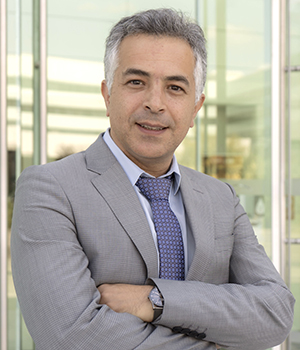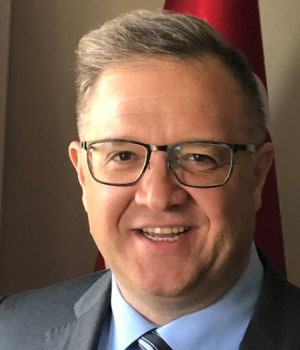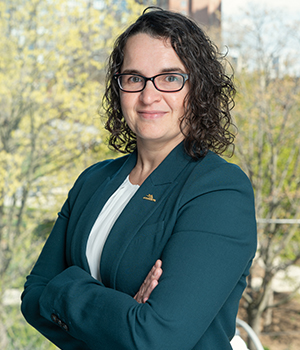Back to program
New Tools to Support Underground Exploration
Wednesday, November 22, 2023
Room 301A - COREM
With the electrification of society, demand for critical and strategic minerals is increasing at a staggering rate. In order to meet this demand, the mining industry must equip itself with exploration tools that will enable it to reduce the risks of exploring and exploiting deposits deep underground. This session will showcase the technological advances available to the mining industry, both here and elsewhere in the world.
This session will be offered in French and in English.
1:30 p.m.
Smart Exploration: Research-Innovation-Action for Sustainable Access to Critical Raw Materials
Conference details
In March 2023, the European Commission announced the new list of critical raw materials for the fifth times. This time, however, was mixed with a new term: “strategic metals”. It was obvious that supply risks and economic importance are not the only measures and future demands must be considered in this era of energy transition and electrification. Hence copper and nickel were also added to the list. These actions are aimed at developing resilient value chains for the EU industrial ecosystems; reducing dependency on primary critical raw materials through circular use of resources, sustainable products, and innovation; strengthening domestic sourcing of raw materials in the EU; and diversifying sourcing from third countries and removing distortions to international trade. Smart Exploration was launched in 2017 under the EU’s Horizon2020 Research and Innovation Programme aimed at developing cost-effective, environmentally friendly geophysical solutions for mineral exploration. The project had a duration of three years and ended in 2020. It involved a consortium of 27 partners from nine EU countries and included several sectors from academia, industry, and local public bodies.
Smart Exploration’s main goal was to change the exploration routines towards entrepreneurial mindset in which both academics and companies are comfortable with risks, look into future and ready to embrace and support new technologies like the procedure practiced in the biomedical industry. Innovation was the cornerstone of the project. It led to five new geophysical prototypes and six methodologies for 3D imaging and modelling. The prototypes were (1) GPS-time transmitter for denied environment, (2) electric seismic vibrator for broadband imaging, (3) modular slimhole system for exploration boreholes, (4) deep-probing helicopter-based transient-electromagnetic system, and (5) a modular magnetic-electromagnetic UAV-based platform. To exemplify their applications, the GPS-time transmitter was used in the world-class Neves-Corvo VMS mine in Portugal to image down-dip extension of the mineralization by simultaneously generating shots and recording in both underground and on the surface using a semi-3D setup employing four exploration tunnels at 690 m depth. Such a survey would have been impossible without this smart and easy to mobilize prototype. The development has since been used in deeper mines in South Africa and Sweden allowing an improved scanning of the subsurface like what MRI scanning systems do. Boldly speaking, Smart Exploration has elevated mineral exploration geophysics in Europe, a legacy to push innovation in this mineral exploration sector in this important era of energy transition.
2:10 p.m.
Deriving Density Using Measured Porosity from Borehole Magnetic Resonance (BMR) Geophysical Logging
Conference details
Rock density measurements are a critical component of rock mass characterization required for almost every industry that relies on the earth’s subsurface for materials and resources or infrastructure engineering, including mining and energy. The combination of measuring the volumes and masses of solid, liquid, and gas components of geologic material – either in a lab using drill cuttings or core samples or in-situ rock measurements using geophysical logging in drill holes – are standard and important measurements for characterizing geotechnical and geomechanical properties. For in-situ rock mass characterization in drill holes, bulk density geophysical logging tools containing a gamma ray radioactive source have been the standard method of measurement.
In recent years, the overall cost of utilizing geophysical logging tools with radioactive sources has increased significantly. This cost can be assessed in terms of storage and containment requirements for nuclear sources, licenses and training for maintaining and using sources, added time involved for preparation and approvals of paperwork and logistics to access work sites, and source storage onsite for extended projects. This is all in addition to the actual field acquisition where the density tool with the nuclear source is lowered into a drill hole that is an inherently unstable and unpredictable environment in which the tool with source may become stuck underground. This possibility of a stuck in hole event increases the liability significantly, as well as the time and cost for recovery of the source when an event occurs.
This rising cost for employing the traditional in-situ nuclear source-based density logging is coupled with the fact that the measurement is indirect, requiring knowledge of the material being measured and corrections for drill hole conditions to calculate the result (hole size, rugosity, sensor offset from side of hole, casing material and size if present, etc.). The measurement itself is bulk density which is the combined density of the rock minerals, water and air present in the pore space. The relationship of the rock and pore space is also important as they are intrinsically linked to each other. When matrix/grain density of the rock volume measured is known, the total porosity can then be determined. Therefore, if knowing matrix density is a requirement to determine rock porosity, could we alternatively use a high-quality measurement of porosity with the same inferred matrix density to calculate bulk density?
This talk will introduce borehole magnetic resonance measurements from WIREBmr logging, which is a direct, lithology-independent measurement of total porosity and pore size distribution in water-filled rock - that doesn’t use a radioactive source - in order to illustrate the method for calculating rock bulk density. Examples containing WIREBmr, density logs and lab test density values will illustrate the comparison and level of BMR bulk density accuracy and resolution, as well as considerations for removing a radioactive source tool, with all the associated cost and risks described earlier, from a geophysical logging program in geotechnical or geomechanical applications.
2:30 p.m.
Directional Drilling: A Customized Tool for Accurately Reaching Deep Exploration Targets
Conference details
Authors: Gervais Perron, R. Nicholls, R. Lindhjem and E. Brandslet (IMDEX Limited)
Over the last few decades, mineral exploration has had to adapt to the reality that more and more deposits are located at depth (> 500 m). This trend looks set to continue. Several innovations in geophysics, geochemistry/mineralogy and structural geology have been developed and are now capable of identifying quality targets at depth. The same applies to the integration of multidisciplinary data and the resulting 3D models. But what about our ability to accurately reach these targets while reducing the time associated with the drilling campaign, the number of meters to be drilled and our environmental footprint? These are the challenges that directional drilling is addressing.
Directional drilling makes it possible to locally change the trajectory of a borehole to meet criteria of 1) deviation control, 2) design with parent/child holes, and 3) flexibility. In this way, it is possible to influence the accuracy with which a target is reached, to reduce the amount of drilling required to reach several targets, to respond to drilling rig location constraints and/or to position a borehole in order to control the angle of entry onto a target. It is also possible to recover a core or not during this process.
The average deviation is around 9° per 30 metres and can be reproduced several times. This is dictated by the maximum curvature that can be transmitted to the drill pipes. Based on these limitations and the various input parameters (number and distance between targets, number and location of collets, etc.), a drilling plan is calculated and a sequence proposed. Most holes require conventional diamond drilling, and directional drilling is used only to correct the trajectory of a hole or to create one or more new child holes. It is important to periodically check the progress of directional drilling using magnetic tools or gyroscopes to ensure accuracy and safety.
The benefits of directional drilling are demonstrated through a case study in a gold-bearing environment in Canada.
2:50 p.m.
Hyperspectral Imaging as a Mineral Exploration Tool
Conference details
Used for nearly twenty years as a geoscientific research tool, hyperspectral imaging is now rapidly becoming more widely used in mining exploration and production. The basic principles of reflectance spectroscopy will be presented, followed by an overview of the hyperspectral tools available and examples of applications in different spectral ranges. The most commonly used tools operate in the visible-near infrared (400-1000 nm) and short-wave infrared (1000-2500 nm) wavelengths, and are used to detect rare earth elements and hydrated minerals respectively. Mid-wave (2500-5000 nm) and long-wave (8000-12000 nm) infrared tools have more recently been introduced to the market, and offer the possibility of directly detecting carbonates and non-hydrated silicates, respectively. Typically, hyperspectral imagers acquire high-resolution spatial data (<1 mm/pixel) over entire boxes of drill core in less than a minute, and can therefore quickly deliver reliable and objective geological data during a mineral exploration campaign, which can help to better target alteration zones. In a production environment, the use of these instruments offers the possibility of rapidly sorting ore. Examples of hyperspectral imaging applications in Canada will be presented in various commodities, including gold, copper and rare earths.
3:10 p.m.
ECORE: Breakthrough Optical Technology for Underground Exploration
Conference details
Authors : Lütfü-Çelebi Özcan, Kheireddine Rifai, Ofure Onodenalore et Florentine Zwillich (ELEMISSION)
Current practice in mineral exploration is to install drills on site and use them to prospect at predefined locations based on remote sensing and/or site prospecting information. Once the drill cores have been extracted from the ground, the logging operation begins. The geologists first report several data points on core samples, then select the most interesting depth intervals to send to the laboratories for elemental analysis. Drilling rigs remain on site until the chief exploration geologist decides that enough information has been gathered from the drill site, or that budgetary expenditure has been reached. The drills are then removed from the site and many prospecting decisions remain on hold until the results of the chemical assays are finally returned from the analytical laboratories, often up to six months later. It's important to note that chemical assays provide the average elemental chemical composition of the entire sample, but they don't provide any quantitative mineralogical information about the sample. An analysis technique that provides real-time results at this stage of exploration would greatly affect deep mining exploration in terms of efficiency, risk reduction and cost reduction.
Instruments for digitizing mining assets were developed at the turn of the century and are now beginning to attract the interest of mining exploration companies. Near-infrared hyperspectral imaging (SWIR, NIR, LWIR) is well known in the field of mineral exploration, whether for gathering information via satellite (Landsat 1 NASA-JPL 1972) or for logging drill cores. Although several companies have worked to improve this molecular spectroscopy technique by adapting it to X-ray spectrofluorescence (an elementary technique) with multi-sensor mining asset digitizers, these advances do not offer any hope of creating a digital twin from a drill core. In contrast, the ECORE technology launched in 2021 is a ground-breaking optical technology innovation in the field of mining asset digitization, which raises the prospect of being able to produce digital twins of drill core.
In this presentation, the use of ECORE technology for digitizing drill cores obtained during deep mineral exploration will be demonstrated for deposits of critical minerals such as lithium and copper. Mineralogical composition and chemical assays in relation to drilling depth will be presented and validated with macroscale chemical assays. In addition, the use of the data generated by ECORE will be presented in a geological model.
3:30 p.m.
Agnico-Eagle's Drilling Laboratory
Conference details
The mining industry is constantly evolving, prompting companies to rethink their current methodologies and review their paradigms. The significant increase in costs, including those associated with mining activities, is driving us to optimize existing processes and to innovate.
Drill core data forms the basis of many of the activities that define today's mining cycle. Hundreds of meters of core are collected every day on exploration and mining sites. Geologists strive to understand the geology of their deposits by qualitatively describing the core samples collected. This poses a number of challenges in terms of consistency, homogeneity and efficiency of drilling descriptions.
Recent advances in commercially available core digitizing technology and the growing use of artificial intelligence represent an opportunity for the mining industry. These technologies offer the possibility of significantly improving the quality of our databases by facilitating the extraction of quantitative mineralogical, lithological, structural and textural data. These data are then used to predict their geological, geotechnical, metallurgical and environmental response using artificial intelligence algorithms. In future years, this technology has the potential to improve and optimize the time spent in the core library and increase confidence in resource and reserve models. This will create a clear advantage for companies, who will have everything in hand to develop their present and future deposits.








